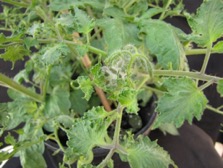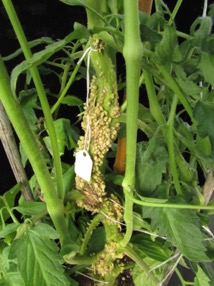A few weeks ago, in Drift 101, I suggested that farmers should be cautious before concluding that sick crops are a result of herbicide drift from neighboring fields. Symptoms attributed to drift may be caused by other factors. Nutrient deficiencies may cause chlorosis (yellowing) and necrosis (tissue death), symptoms easily misinterpreted as resulting from herbicide exposure (https://vegnet.osu.edu/sites/vegnet/files/imce/newsletters/VegNet/5-31-16%20VegNet%20Vol%2023%20Issue%207myedits.pdf).
The herbicides 2,4-D and dicamba invariably cause distorted growth of foliage (Figure 1), but so can various environmental pollutants especially when those are concentrated in the greenhouse (Figure 2).

Figure 2: Distorted growth of greenhouse tomato thought caused by fumes from incomplete combustion from wood heater. Photo courtesy of M. Badertscher (OSUE Hardin Co).
Likewise flood conditions, during which root systems are completed saturated with water for prolonged periods, are known to induce leaf twisting and formation of adventitious roots (Figure 3), symptoms associated with exposure to 2,4-D (Figures 1 & 4).

Figure 3: Adventitious root formation on stem of tomato following 3 days of flooding conditions (root zone saturation).
Even when herbicides are the cause, symptoms can occasionally be misleading and point incorrectly to a nearby field. Consider the case of glyphosate, still the most commonly used herbicide in the Midwest. Glyphosate is quickly absorbed by crop leaves and translocated to growing points. On most crops glyphosate damage becomes obvious 4 or more days after drift because new growth is chlorotic. On tomato, chlorosis most often appears as bands across the base of the leaflets (Figure 5). However in a small number of drift events, chlorosis may not appear at all; instead glyphosate induces leaf and petiole curling and twisting, symptoms reminiscent of 2,4-D or other synthetic-auxin herbicides.

Figure 6: Occasional ‘auxin-mimic’ symptoms that occur in a small percentage of glyphosate drift events.
Soil residues of environmentally persistent herbicides used in previous growing seasons must also be taken into account. Trace amounts of herbicides in the ALS and AHAS families can cause symptoms similar to those caused by 2,4-D and dicamba. Imazethapyr (Pursuit) is an AHAS herbicide used on soybean that controls weeds at low doses of 3-6 oz/Acre. In our lab, tomato flowering was sensitive to doses of the herbicide equivalent to 1/1000th of the field dose. This finding indicates that soil residues of imazethapyr applied two or more years before planting may still be sufficient to injure field grown tomato, as may drift of the herbicide from a nearby or not-so-nearby application.
Many more similar examples could be provided; hopefully, the take home message is that diagnosing crop injury symptoms is a complicated matter that must take several factors into consideration and can easily lead to mistakes being made. Tread cautiously.


